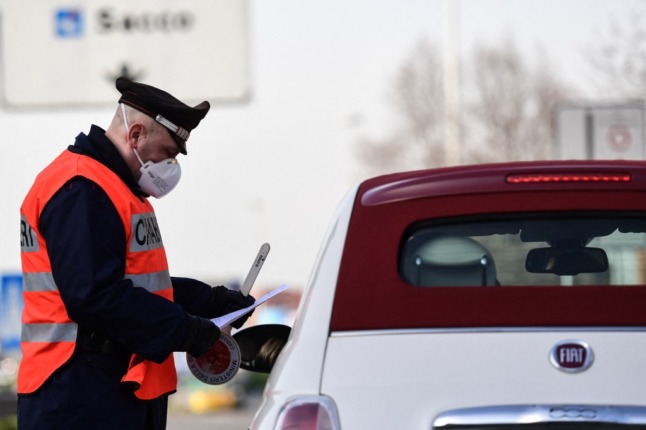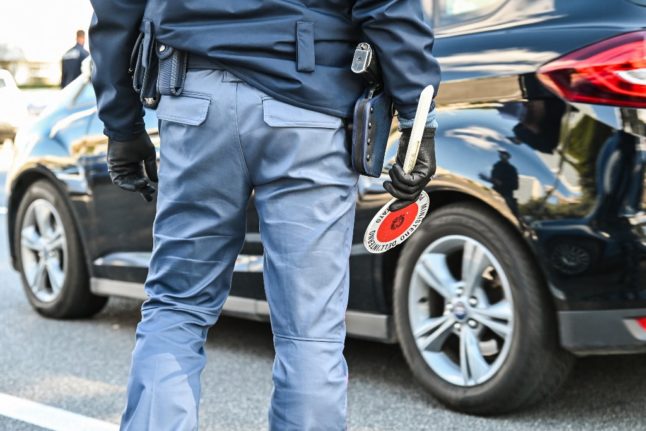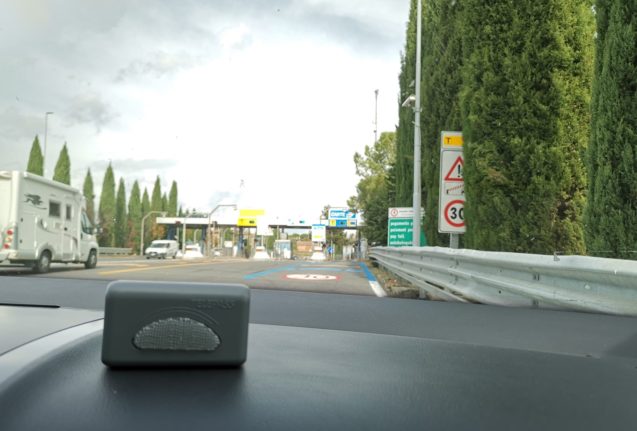It’s a souvenir nobody wants to open after they return from their Italian travels – a traffic fine.
For tourists driving in Italy, getting slapped with a ticket for breaking the rules of the road is a common problem. This could be because you don’t know the rules of the road when you’re a visitor and naively infringe Italy’s Highway Code.
Unfortunately, as many people find out, the costs of breaking Italy’s traffic regulations can be high and difficult to contest, particularly from abroad.
Here’s an overview of the most common ways you can get caught out and what to do if you do receive a penalty.
Speeding tickets
Going too fast is easily done when driving in Italy, considering that you might not know the speed limit for the road you’re on and that Italy has the most speed cameras in Europe.
In fact, the speed limit not only changes depending on the road you’re driving on, but also depending on the type of vehicle and the weather conditions.
That’s to say nothing of the fact that Italian drivers often aren’t following the speed limit, but the speed other drivers are going at. While they know when and where to slow down for cameras and police checks however, visitors probably won’t.
READ ALSO: Who needs an international permit to drive in Italy?
Keep in mind that urban roads are usually limited at 50km/h – sometimes 30km/h in really built-up areas – and the motorway permits speeds of up to 130km/h.
You should be able to see what the relevant limit is for the road you’re on with the figure displayed in round road signs, but for full details, see article 142 of the Italian Highway Code.
If you exceed the speed limit, speed cameras or ‘autovelox‘ will take a photo of your number plate and your fine will be calculated depending on how far over the limit you were going.
You may also see a camera ‘Tutor‘, which calculates the average speed you drive at on a given stretch of road.
Fines start at €42 but can run into the thousands. The above link to the Highway Code has further details for how much you could expect to pay depending on the level of your violation.
The speed limits are not absolute however – there is five percent of leeway, so if you were driving at 72km/h in a 70 zone, you won’t get fined.
ZTL fines
These traffic fines catch out even wily Italian drivers occasionally. The signs can be easy to miss, even if you’re looking for them – you may not be familiar with the ZTL concept at all.
If you see a round road sign, a red circle containing the letters ‘ZTL’, you can’t drive down that street unless you have a special permit (and if you’re just visiting Italy, it’s unlikely that you will have one).
READ ALSO: What are the longer-term alternatives to car hire in Italy?
ZTL stands for Zona Traffico Limitato (Restricted Traffic Zone) and you’re most likely to find them around congested parts of inner cities, and in the historic areas of town centres where streets are narrow and parking scarce. They’re intended to reduce pollution and congestion, so the only vehicles allowed to enter a ZTL are residents or those working for businesses in the area.
If you unwittingly sail past one, the camera will take a shot of your registration number and you’ll get a fine of between €83 and €332, plus administrative costs, according to article 7 of the Highway Code.

Be aware that you’ll likely have to pay for each time you went down a ZTL road: costs which can quickly mount up if you get lost and are driving around a historic centre in circles.
If you’re staying in a hotel within a ZTL, you should be able to drive to it and park there – as long as you communicate with the hotel first that you’ll be arriving by car and you give them your registration plate number.
READ ALSO: The traffic signs you need to know about when driving in Italy
The hotel can then submit that to the database of permitted vehicles on your behalf and you won’t be subject to any ZTL fines.
However, remember that some hotels may say you can drive to drop off your luggage and then instruct you to leave your car outside the restricted zone.
Check before travel and keep all booking confirmations and hotel correspondence in case the hotel forgets to enter your car details into the ZTL database.
Parking fines
Parking in Italy can really grind your gears. It may take a long amount of driving around to find a free space and some towns’ paid parking can be costly.
It’s worth researching first where to park and where to find the cheapest spots to save you losing your cool. If you do that, you’ll only end up spending a few euros and avoid much steeper fines.
READ ALSO: How to pay Italian traffic fines from abroad
The amount of parking fine types you can incur in Italy are numerous.
If you don’t use a dedicated car park with a ticket on entry or exit, watch out for the different coloured lines. Blue lines mean you have to pay to leave your car there, usually via a parking metre.
If you find a spot in a parking metre zone, you’ll need your licence plate number when you enter how much time you want to stay for. These metres are required to accept coins, notes and bankcards – but make sure your card is authorised for use abroad if you want to pay this way.
Check how long the payment hours are – some are free after 6pm – 8pm anyway.

There are also parking apps you can download ahead of time, like EasyPark, which is one of the most useful in Italy as it covers hundreds of Italian cities – and other European countries beyond. You can also try Phonzie, which has the option to buy bus tickets. Alternatively, look on the metre itself for different ways to pay, as some cities have their own parking app.
Parking apps also let you add on more time to your parking, no matter where you are – pretty useful if you’re the other side of town and realise you have five minutes left on your ticket.
READ ALSO: ‘Expect the unexpected’: What you need to know about driving in Italy
Take care with yellow lines, as they are reserved for certain users, such as residents, workers or for going to the pharmacy.
If you overstay or park in the wrong place, the fine again depends on how much over the limit you go. Fines begin at around €40, but can go into the hundreds if you choose to ignore the fine and not pay it – more of that below.
If you see parking spots indicated by white lines, anyone can use those and they are usually free – but always check the roadside for any signs or instructions in case.
Driving in bus lanes
As much as you need to look up for road signs while driving in Italy, keep your eyes down on the road too to check for bus lane markings.
You can get landed with a fine if you get distracted and wander into a lane reserved for public transport.
This can set you back anywhere between €87 and €344, according to article 7 of the Highway Code.
What happens if I get a fine?
Firstly, it’s important to remember that any infringements you committed on Italy’s roads may take a while to sting.
If you live abroad, the police have 360 days to send you the fine; if the car is rented, the time limitation is the same for foreigners but the period starts from the date of receipt of your data by the rental company. Of course, this may then take longer to then get to you.
| Banner ad |
This is because the police have 90 days to issue a fine to the vehicle’s registered address in Italy. The car rental company then has 60 days to send the police your data and then the process begins again from the police contacting you directly.
Read more about paying Italian traffic fines from abroad here.
Note that rental companies may charge you administrative costs on top of the fine.
As you will have signed a rental agreement and authorised use of your credit card, they will most likely directly charge your card for the costs plus VAT. Keep records of this in case you manage to dispute the fine and claim back these added fees from the rental firm.
The deadline to pay depends on how you received the penalty.

If you found a ticket on your windshield, you usually have 15 days to pay. If you receive it in the post, you have 60 days but will get a 30 percent discount if you transfer the funds within five days, according to article 202 of the Italian Highway Code.
If you exceed the terms of 60 days, the fine will increase and will keep increasing for late payment interest.
You can pay the fine from abroad either by bank transfer or some municipalities allow you to pay online via a debit or credit card.
You can appeal against the fine if you believe you have good grounds to do so.
But it’s worth bearing in mind that it really has to be worth the effort, as paying the fine immediately with a 30 percent reduction is likely to be the least hassle.
Find out more about disputing a ticket here.
What happens if I just don’t pay a fine?
The ticket will continue to accrue interest and rise. The municipality may enlist a debt collection agency and at that point, you’ll no longer be able to contest the ticket.
Please note The Local is unable to advise on individual cases. See full details of Italy’s Highway Code here and visit our travel section for the latest updates.



 Please whitelist us to continue reading.
Please whitelist us to continue reading.
What about the “environmental zones” that Google maps announced in areas around Torino and Milano? I assume that my new rental care (diesel) met the requirements but it was new to me and I await my. fines…. Thanks.